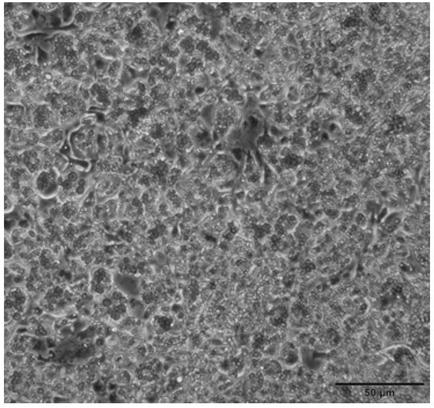3D printed adipose tissue
A 3D printing, adipose tissue technology, applied in tissue culture, bone/connective tissue cells, drug combination, etc., can solve the problems of limited application of adipose tissue treatment, limited quantity, difficult transplantation of soft tissue, etc., to achieve the function of cell secretion. Effect
- Summary
- Abstract
- Description
- Claims
- Application Information
AI Technical Summary
Problems solved by technology
Method used
Image
Examples
Embodiment 1
[0042] Embodiment 1 Configuration of mixed culture medium and adipocyte induction medium
[0043] The composition of the mixed culture medium is: DMEM F12+10% FBS+1% streptomycin+1% penicillin. The mixed culture solution was sterilized by 0.22 μm filter at 37 °C, 5% CO 2 Equilibrate in the incubator for 2-4 hours.
[0044]Adipocyte induction medium component I: MEM / F12+10%FBS+streptomycin+penicillin+5ug / mL insulin+1nM 3,3',5-triiodo-L-thyronine (T3); 0.22μm filter After sterilization at 37 °C, 5% CO 2 Equilibrate in the incubator for 2-4 hours.
[0045] Adipocyte induction medium component II: MEM / F12+10%FBS+streptomycin+penicillin+5ug / mL insulin+1nM3,3',5-T triiodo-L-thyronine (T3)+125uM indole Methacin + 0.5mM 3-isobutyl-1-methylxanthine (IBMX) + 0.5uM rosiglitazone; 0.22μm filter sterilization at 37°C, 5% CO 2 Equilibrate in the incubator for 2-4 hours.
Embodiment 2
[0046] Example 2 Obtaining brown adipocytes
[0047] Take out the mouse scapular fat under aseptic conditions, carefully remove the surrounding white adipose tissue, wash 3 times with PBS (containing 1% penicillin and streptomycin), remove blood clots and mucus on the surface of the tissue, put it into a petri dish, and place the Cut up the adipose tissue and add collagenase D digestion mixture (1.5U / mL collagenase D+2.4u / mL DipaseⅡ+25mL PBS+10mM CaCl 2 ) 10ml, mix well, place in a water bath at 37°C for 60min, shake and digest; centrifuge at 700g for 10min, the adipocytes are located at the bottom of the centrifuge tube; after pouring off the supernatant, add 10ML of medium to resuspend the cells at the bottom, and repeatedly pipette to mix After uniformity, filter through a 70-mesh filter to remove undigested tissues, and collect the filtrate; obtain a crude mixture of adipocytes and other impurities.
[0048] Isolation of precursor cells in adipose tissue by differential a...
Embodiment 3
[0049] Example 3 Preparation of 3D printed brown adipose tissue
[0050] 1. Design and preparation of biocompatible scaffolds for 3D printed brown adipose tissue
[0051] (1) Combining with computer aided design (CAD), three-dimensional printing technology is used to construct the bracket, in which the shape, composition and internal structure are well designable;
[0052] (2) The shape of the three-dimensional adipose tissue is designed to be similar to the shape of adipose tissue, and the internal structure is guaranteed to have a certain pore structure;
[0053] (3) The compatibility of gelatin (10%) was selected as the printing material of the biocompatible scaffold for printing.
[0054] (4) Internal structural parameters of the constructed biocompatible scaffold: pore size (R) = 0.2mm; line stacking angle: 90°
[0055] (5) Store the prepared biocompatible scaffold at -80°C for future use.
[0056] 2. Preparation of 3D artificial adipose tissue
[0057] The preadipocy...
PUM
 Login to View More
Login to View More Abstract
Description
Claims
Application Information
 Login to View More
Login to View More - R&D
- Intellectual Property
- Life Sciences
- Materials
- Tech Scout
- Unparalleled Data Quality
- Higher Quality Content
- 60% Fewer Hallucinations
Browse by: Latest US Patents, China's latest patents, Technical Efficacy Thesaurus, Application Domain, Technology Topic, Popular Technical Reports.
© 2025 PatSnap. All rights reserved.Legal|Privacy policy|Modern Slavery Act Transparency Statement|Sitemap|About US| Contact US: help@patsnap.com



